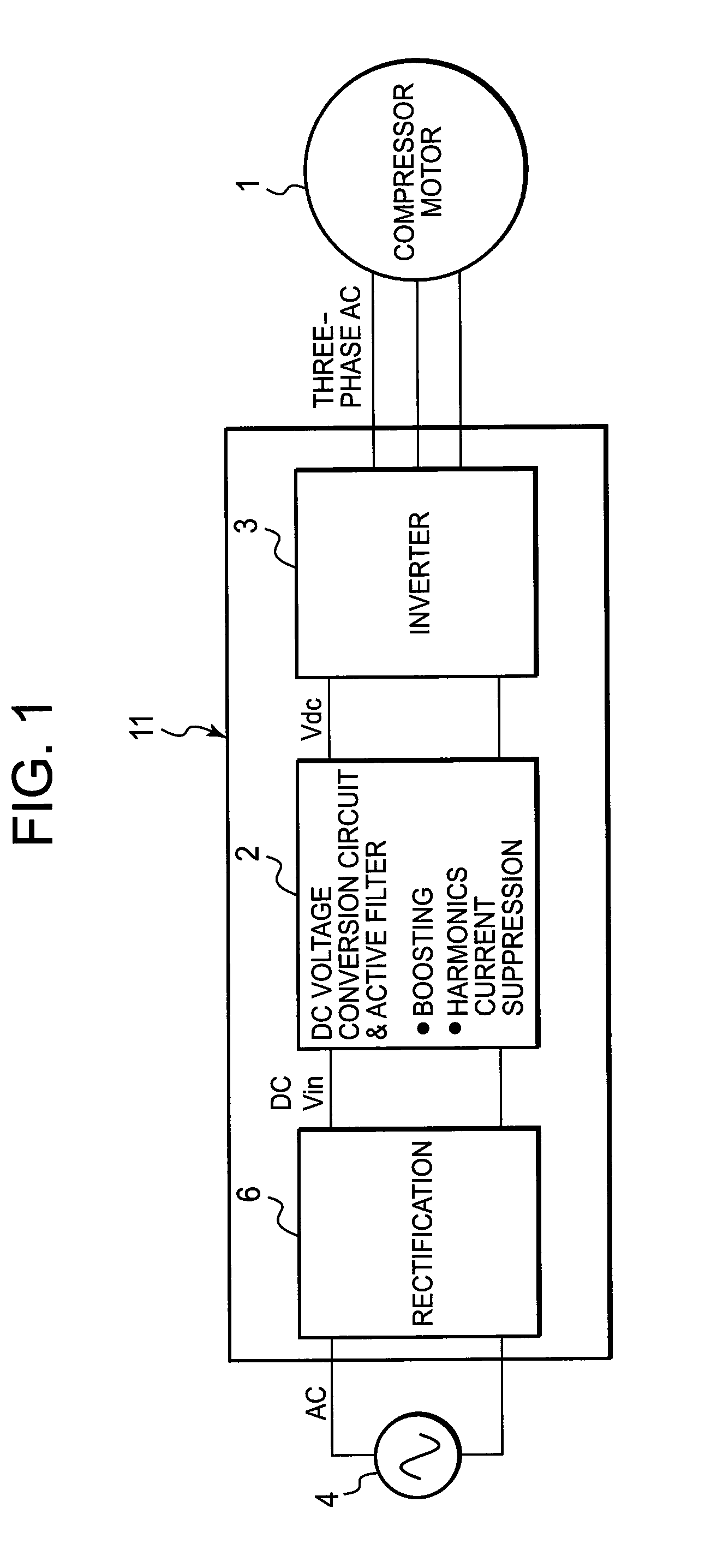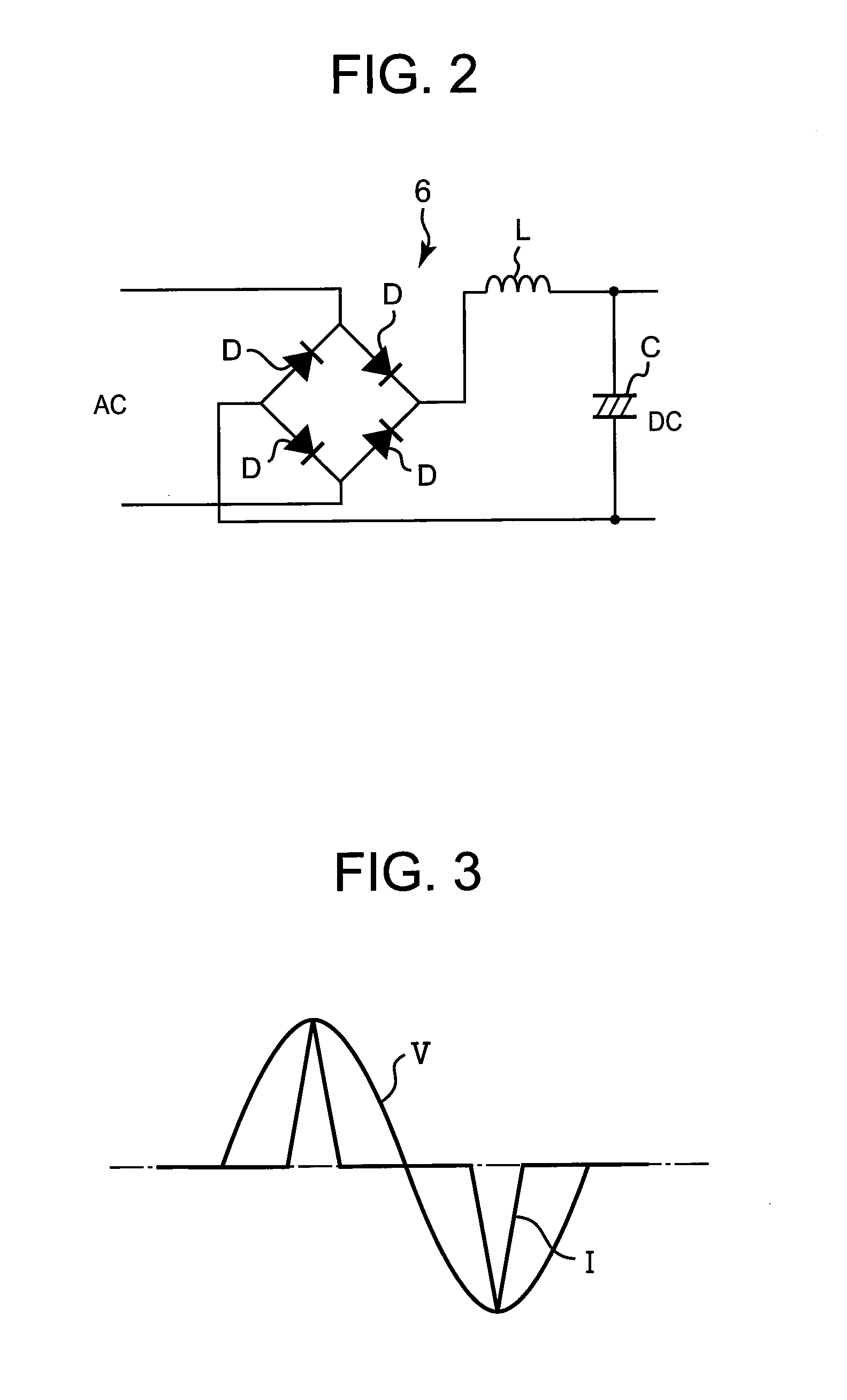Drive for motor
a technology for driving motors and motors, applied in the direction of dynamo-electric converter control, dynamo-electric gear control, electric generator control, etc., can solve the problems of motors not being able to operate power consumption vceic (this causes a loss), and the motor cannot be operated up to a high load, so as to reduce the current flowing through the motor, improve the efficiency of inverters, and increase the capacity of voltage conversion circui
- Summary
- Abstract
- Description
- Claims
- Application Information
AI Technical Summary
Benefits of technology
Problems solved by technology
Method used
Image
Examples
embodiment 1
[0088]Next, FIG. 8 is a flowchart illustrating an exemplary actual control operation by the controller 14. At Step S1 of FIG. 8, the controller 14 firstly executes the first modulation factor adjustment mode as the control method of FIG. 4, where the output voltage Vdc output from the voltage conversion circuit 2 is controlled in accordance with the modulation factor (a / d) feed back from the inverter 3 so that the modulation factor can be 0.9 as the target value (become closer to 1).
[0089]At the following Step S2, judgment is made as to whether the output voltage Vdc currently output from the voltage conversion circuit 2 is larger or not than the upper limit a in the above-described upper and lower limit setting unit, for example. Then, if it is not more than the upper limit a, the controller 14 proceeds to Step S3 to continuously execute the DC voltage adjustment control in the first modulation factor adjustment mode that is being currently executed.
[0090]Herein, when the motor 1 b...
embodiment 2
[0095]Next, FIG. 10 is a flowchart illustrating another exemplary actual control operation by the controller 14. Firstly at Step S5 of FIG. 10, the controller 14 similarly executes the first modulation factor adjustment mode as the control method of FIG. 4, where the output voltage Vdc output from the voltage conversion circuit 2 is controlled in accordance with the modulation factor (a / d) feed back from the inverter 3 so that the modulation factor can be 0.9 as the target value (become closer to 1).
[0096]At the following Step S6, judgment is made as to whether a difference (Vdc−Vin, i.e., the boost width) between the output voltage Vdc that is the DC voltage currently output from the voltage conversion circuit 2 and the input voltage Vin of the voltage conversion circuit 2 is larger or not than a predetermined upper limit α in this case (the upper limit is a limit of the boost width by the voltage conversion circuit 2). Then, if it is not more than the upper limit α, the controller...
embodiment 3
[0101]Next, FIG. 13 is a flowchart illustrating another exemplary control operation by the controller 14 of FIG. 8. In this case, the controller 14 switches between the first modulation factor adjustment mode and the second modulation factor adjustment mode while considering a predetermined hysteresis width 2β in addition to the control of FIG. 8. That is, at Step S9 of FIG. 13, the controller 14 firstly resets a flag X (set as 0). At the following Step S10, the controller 14 executes the first modulation factor adjustment mode as the control method of FIG. 4, where the output voltage Vdc output from the voltage conversion circuit 2 is controlled in accordance with the modulation factor (a / d) feed back from the inverter 3 so that the modulation factor can be 0.9 as the target value (become closer to 1).
[0102]Next, at Step S11, judgment is made as to whether the flag X is reset or not. Since it is reset, the procedure goes to Step S12, where judgment is made as to whether the output ...
PUM
 Login to View More
Login to View More Abstract
Description
Claims
Application Information
 Login to View More
Login to View More - R&D
- Intellectual Property
- Life Sciences
- Materials
- Tech Scout
- Unparalleled Data Quality
- Higher Quality Content
- 60% Fewer Hallucinations
Browse by: Latest US Patents, China's latest patents, Technical Efficacy Thesaurus, Application Domain, Technology Topic, Popular Technical Reports.
© 2025 PatSnap. All rights reserved.Legal|Privacy policy|Modern Slavery Act Transparency Statement|Sitemap|About US| Contact US: help@patsnap.com



